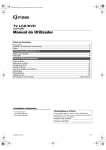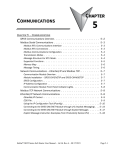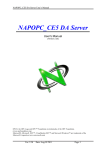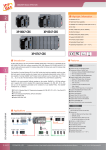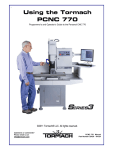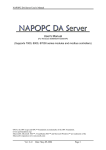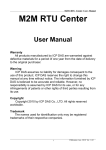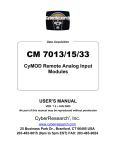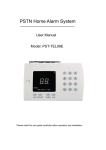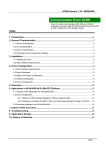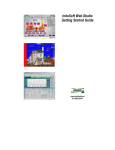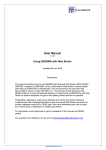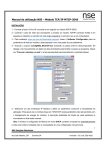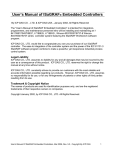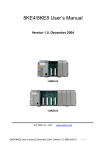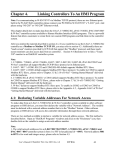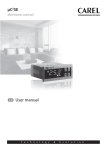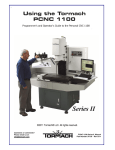Download ICP DAS Solution for Indusoft Web Studio
Transcript
Manual for InduSoft Web Studio Solution (version 1.02) Produced by ICPDAS LTD., Co. Page 1 Index ICPDAS solution for InduSoft Web Studio ........................................................................................4 Section 1: Bundled Driver for InduSoft Web Studio..........................................................................7 1-2 General Characteristics...........................................................................................................9 1-2-1 Device Characteristics........................................................................................................9 1-2-2 Link Characteristics............................................................................................................9 1-2-3 Driver Characteristics.........................................................................................................9 1-2-4 Information about conformance testing ...........................................................................10 1-3 Installation the driver............................................................................................................10 1-3-1 Install DCON Driver into InduSoft Web Studio .............................................................. 11 1-3-2 Other software requirements ............................................................................................13 1-4 Driver Configuration.............................................................................................................14 1-4-1 Driver configuration .........................................................................................................14 1-4-2 Driver Worksheet..............................................................................................................16 1-4-3 Station and Header configuration.....................................................................................18 1-4-4 Address Configuration......................................................................................................18 1- 5 Driver Execution Setting ......................................................................................................20 1-6 DCON Driver Troubleshooting ............................................................................................21 1-7 Application Sample................................................................................................................22 Section 2: NAPOPC DA for InduSoft ..............................................................................................29 2.1 NAPOPC DA Server ..............................................................................................................29 2-2 InduSoft Web Studio..............................................................................................................31 Section 3: NAPDDE Server for InduSoft Web Studio .....................................................................42 3-1 NA7000D DDE Server...........................................................................................................42 3-2 NAP7000D DDE server for InduSoft Web Studio ..............................................................47 Section 4: ModBus/TCP for InduSoft Web Studio...........................................................................52 Page 2 4-1 Modbus Utility .......................................................................................................................52 4-2 InduSoft Web Studio..............................................................................................................55 4-3 Analog input and Analog output value converter formula:...............................................61 Analog input Converter formula:...............................................................................................61 Analog Output Converter formula: ............................................................................................62 Section 5: ISaGRAF (I-8xx7, I-7188XG, I-7188EG) for InduSoft Web Studio..............................64 5.1 The definition of ISaGRAF Soft PLC ..................................................................................65 5-2 The InduSoft Web Studio communicating with ISaGRAF Soft PLC ...............................77 5-2-1 Use I-8X17 and I-7188XG Modbus RTU series modules of ICPDAS products .............77 5-2-2 Use I-8X37 and I-7188EG Modbus TCP series modules of ICPDAS products ..............84 Appendix A ........................................................................................................................................92 Installing DCON Driver into InduSoft development environment .........................................92 Appendix B ........................................................................................................................................95 Installing an InduSoft SoftKey License on the WinCon-8x39 .................................................95 Installing or Upgrading a License Locally.................................................................................95 Installing or Upgrading a License Remotely .............................................................................99 Page 3 ICPDAS solution for InduSoft Web Studio InduSoft Web Studio is a powerful, integrated collection of automation tools that includes all the building blocks needed to develop human machine interfaces (HMIs), supervisory control and data acquisition (SCADA) systems, and embedded instrumentation and control applications. InduSoft Web Studio can run in native Windows NT, 2000, XP and CE environments and conforms to industry standards such as Microsoft DNA, OPC, DDE, ODBC, XML, SOAP http://www.InduSoft.com/. Page 4 and ActiveX. For more information please visit: Page 5 The Above figure illustrates the integration application for ICP DAS products and InduSoft Web Studio. InduSoft provides the stability and reliability software system for HMI, SCADA and Web solution. And ICP DAS supplies the good performance hardware with suitable firmware or controller. From the demonstration, ICP DAS proposes remote I/O, I-7000, I-8000, I-87K series modules and embedded controller, such as ISaGRAF based products and I-7188 series. Furthermore, ICPDAS also provides several of the standard Industry communication tool kits and software kits, such as OPC, DDE, Modbus, bundled driver, NAP7000D, NAPOPC, 7000Utility, …, through Rs-232/Rs-485/Ethernet media to help user to easily communicate and control the remote or embedded modules in various application system. On the other hand, InduSoft provides a software platform such that users can easily build a small to large SCADA system within a short time. Eventually, the cooperation of ICPDAS and InduSoft can provide an easy application solution for system integrator even for simple to complex system. Note that this manual will focus on communication setting demonstration for Software and hardware. Based on the application structure, we will show five solutions for InduSoft Web Studio, which are Bundled driver, OPC server, DDE server, Modbus TCP, ISaGRAF Soft PLC solution. Firstly, the Bundled driver solution for InduSoft will be presented in section 1. Section 2 and 3 will introduce the OPC and DDE server solution. Modbus TCP is the international communication protocol for field bus control system. Therefore, this Modbus TCP solution for InduSoft will be discussed in section 4. Finally, ISaGRAF Soft PLC solution for InduSoft, which is based on Modbus RTU and TCP, will also be established in section 5. In addition, every solution only gives a simple example for InduSoft Web Studio how to connect to hardware system. If users need to know more knowledge for how to use InduSoft Web Studio SCADA design skill, please refer to the technique reference manual of InduSoft Web Studio software. Page 6 Section 1: Bundled Driver for InduSoft Web Studio 1-1 Introduction ICPDAS develops the bundled “DCON” driver to enable InduSoft Web Studio to communicate with some series of remote control modules, such as, I-7000 series, I-8XX1 I-8XX0 series, and I-87K series. Due to this driver was developed base on the DLL driver of ICPDAS, therefore, it provides two communication methods for his products:(1) the first one is RS232 to RS485 series communication by the I-7520 (RS-232 to RS485 converter), (2) the second one is the Ethernet communication scheme by the VxComm driver of ICPDAS (For more information, please refer to website http://www.icpdas.com/). By using these two schemes, allows InduSoft Web Studio to use the series communication method to connect to RS-485 and Ethernet remote control modules. The more detail application of modules and communication scheme are shown in the following figure and tables. Type Support Modules I-7011/7012/7013/7014/7016/7017/7018/7033/8017/8017H/87013 Analog Input Module /87016 /87017/87018 Analog Output Module I-7016/I-7021/I-7022/I-7024/87022/87024/87026/8024 I-7011/12/14/16, I-7041/44/50/52/53/55, I-7060/63/65, Digital Input Module I-8051/52/53/54/55/63 and I-87051/52/53/54/55/63 I-7011/12/14/16, I-7042/43/44/50, I-7060/63/65/66/67/80, Digital Output Module I-8054/55/56/57, -8060/63/64/65/66/68, I-87054/55/56/57 and I-87060/63/64/65/66/68 Time/Counter Module I-7080, I-8080/81/83, and I-87082 Page 7 Besides, the documentation for DCON driver will be organized as following 8 parts: Introduction: Provides an overview of the driver documentation. General characteristics: Provides information necessary to identify all the required components (hardware and software) necessary to implement the communication and global characteristics about the communication. Installation: Explains the procedures that must be followed to install the software and hardware required for the communication. Driver configuration: Provides the required information to configuration the communication driver such as the different permutations for configuration and its default values. Execution: Explain the steps to test whether the driver was correctly installed and configuration. Troubleshooting: Supplies a list of the most common error codes for this protocol and the procedures to fix them. Application Sample: Provides a sample application for testing the configuration the driver. History of versions: Provides a log of all the modifications done in driver. Note: This document presumes that the user has read the chapter of Driver Configuration in the InduSoft Web Studio’s Technical reference manual. Page 8 1-2 General Characteristics 1-2-1 Device Characteristics The following table shows that this driver is designed for ICPDAS products and what series modules are supported. Compatible Equipment I-7000 series remote control modules I-7011, I-7012, I-7013, I-7033, I-7014D, I-7016, I-7017, I-7018, I-7021, I-7022, I-7024, I-7041, I-7042, I-7043, I-7044, I-7050, I-7052, I-7053, I-7060, I-7063, I-7065, I-7066, I-7067, I-7080 I-8000 series remote control modules I-8017H, I-8024, I-8040, I-8041, I-8042, I-8050, I-8051, I-8052, I-8053, I-8055, I-8056, I-8057, I-8058, I-8060, I-8063, I-8064, I-8065, I-8066, I-8068, I-8069, I-8080, I-8081, I-8083 I-87k series remote control modules I-87013, I-87016, I-87017, I-87018, I-87022, I-87024, I-87026, I-87051, I-87052, I-87053, I-87054, I-87055, I-87057, I-87058, I-87063, I-87064, I-87065, I-87066, I-87068, I-87082 Note: Please refer to section 1-2-4 to see the Equipment used in the standard conformance tests for this driver. Note: All analog modules must be configured to engineering units. Note: This Driver version does not implement the CRC. The equipment must be configuration to does not use CRC check. 1-2-2 Link Characteristics Device communication part RS-232 port Ethernet port Physical protocol RS-232/RS-485 Ethernet/RS-485 Logic protocol: ASCII ASCII Device Runtime software DCON driver, DCON and VxComm driver Specific PC Board None None 1-2-3 Driver Characteristics The driver operation System is available for: Page 9 - Windows 9x - Windows 2000 - Windows XP - Windows NT - Windows CE The driver is composed of the following files: DCON.INI: Internal files of the driver, it should not be modified by the user. DCON.MSG: This file contains the error messages for each error code. It is an internal file of the driver the users should not modify it. DCON.PDF: This document provides detailed documentation about the driver. DCON.DLL: This is the compiled library for the driver Note: All the files above must to be in the subdirectory /DRV of the Studio’s installation direction. 1-2-4 Information about conformance testing (1) Family 7000: 7012, 7021, 7060, 7017, 7018 (2) Family 8000: I-8410 (Main unit), 8064, 8053, 8024 Baud Rate: 9600 Configuration Protocol: ASCII (Proprietary) Data Bits: 8, Stop Bits: 1, Parity: None Communication port: Com 1, Ethernet Twin wire Cable Development System Development: Windows 2000, Windows XP NT4.0, Windows 2000, Windows XP, WinCE Operation System Ver. 4.4 and Ver. 5.1 Studio Version DCON Ver. 1.01 and VxComm driver Driver version Equipment 1-3 Installation the driver When you install the Studio v4.4 or higher version into your system, the communication Page 10 drivers should be already installed. Users only need to know how to select the driver and add it to the application where it will be used. Following is the procedure step for how to add the driver DCON into an application: 1-3-1 Install DCON Driver into InduSoft Web Studio Step 1: Execute the InduSoft Web Studio and select the proper application, as below figure. Step 2: Click on the "Add/Remove drivers” menu item to pop up the available communication driver window, as shown in below figure. Page 11 Step 3: In the column Available Drivers list, select the DCON Driver and click the button “Select>>” to add DCON driver into the selected drivers list. (Note: If DCON driver is not found in “Available drivers” list, please refer to appendix A to setting DCON driver into InduSoft Web Studio.) Step 4: When driver DCON appear in the column Selected Drivers, then click “OK” bottom to add driver to InduSoft Web studio. Page 12 1-3-2 Other software requirements If users try to use the Ethernet communication solution for InduSoft Web Studio, the VxComm driver from ICPDAS need to be installed into the system where the application is developed for. Besides, users should also need to define the Ethernet Protocol and assign it to mapping to a Com port. And then users can use the Ethernet communication just like the series communication, which you have assigned it. Page 13 1-4 Driver Configuration After the driver is installed into Studio (see section 1.3), user should proceed to the driver configuration procedure to enable the correct communication protocol with remote control modules. The driver configuration is operated as two parts: (1) The first is the setting or Communication parameters of the driver, which is the driver protocol definition. (2) The second one is the setting of Driver Worksheets, which define the method for how to communicate with variable tags. The more detail procedure for configuration of these two parts will be described in following sub-section. 1-4-1 Driver configuration These parameters are valid for all driver worksheets configured in the system. To open the window for configuration of Communication parameters, Please follow these steps: Step 1: In the Workspace of the Studio environment selects the “Comm” table. Step 2: Expand the folder Driver and select the subfolder DCON. Step 3: Right click on the DCON subfolder and select the option Settings. Step 4: When selecting the Settings, there is a communication parameters window to be popped up for configuring the protocol. Please select the correct parameters to conform to the remote control modules. The station parameter is not used in DCON driver. The more detail parameter setting and description is presented in the below table. Page 14 Parameter Default Value COM COM2 Baud Rate 9600 Data Bits 8 Stop Bits 1 Parity None Valid values Description Serial port of the PC used to COM1 to COM8 communication with the device. 110 to 57600bps Communication rate of data. Number of data bits used in the 5 to 8 protocol. ICPDAS Data Bits is 8. Number of stop bits used in the 1 or 2 protocol. ICPDAS Stop bits is 1. Even, odd, none, space or Parity of the protocol. ICPDAS mark parity is None. Note: These Parameter must be the same as the remote control modules of ICPDAS products. Besides, DCON Driver does not use CRC. Therefore, users should disable checksum function of the modules. Step 5: By clicking on the button “Advanced…”in the window of Communication Parameters, the “advanced settings” window for additional communication parameter will be opened as follow. Users can further define the communication property of the driver in InduSoft Web Studio. description. Page 15 Please define the parameters as the figure Note: The Advanced setting parameters are explained at the Studio Technical Reference Manual. And you should keep the default values to all field described at the next tables should be configured. 1-4-2 Driver Worksheet After the communication parameter settings in above description, then users need to add driver worksheet into Studio’s application to enable communication between the input/output values with variable tags of user application. Each of the worksheet composes of a Header and Body. In order to optimize communication and ensure better performance of the system, it is important to add the tags in different driver sheets according to the events that must be triggered in the communication of each group of tags and the periodicity for which each group of tags must be written or read. That means that tags are separated in the different worksheets based on AI, AO, DI, DO…, which is defined in Header, Besides, it is also recommended to configure the addresses of communication in sequential blocks in the worksheet. Followings are the procedure for how to create a new driver worksheet: Step 1: In the Workspace of the Studio environment, select the table Comm. Step 2: Expand the folder Drivers and select the subfolder DCON. Step 3: Right click on the DCON subfolder and select the option Insert. Page 16 Step 4: When a communication table has been created, following window will be presented. All entries of the Driver Worksheet (exception by the Station, Header and Address) are standards for all communication drivers of InduSoft Web Studio. Users should refer to Studio Communication Driver documentation to know how to configure these standard fields. Here, this manual will only describes how to define the Station, Header and Address fields of DCON driver. These fields usually have specific way for each communication driver. Step 5: Define Head, Tag Name, and Address of remote control modules. For how to correctly input parameter, please refer to the following description. Page 17 1-4-3 Station and Header configuration Parameter Station Default Value Valid value Header AI See next table Description Not used Define the type of variable to be read or written from or to the device. The Header field defines the type of variables that will be read or written from or to the device. It complies with the syntax: <Module’s Type>. After keying in the field Header, the system will check if it is valid or not. If the syntax was incorrect, the default value (AI) will be automatically placed in the field. Note that header define the property of worksheet. And it is recommended to add all of the same property of the tags into the worksheets. Information regarding the parameter “Header” Valid range of Type Sample of syntax Comment initial Address Read Digital DI Any Input/Output Read Digital Output DO Any Read Analog The ICP DAS device channel must AI Any input/output be configured to engineering units The ICP DAS device channel must Write Analog Output AO Any be configured to engineering units Read/Set Counter Counter Any Read/Set DI DICounter Any Counter value Write Command SendCmd Any Send command to the device Note: Always create two different driver worksheets to read Input and Output. 1-4-4 Address Configuration In the body fields of the driver worksheet, it allows users to associate each tag to corresponding channel of device by independence address. In the column Tag Name, you must type the tag from your application database. This tag will get or send values from or to the corresponding device of the defined address. The address cells for remote control module of ICPDAS products will be complied with the following syntax (1) I-7000 and I-87k remote control modules: <Module’s Address>: <Module ID>: <Channel Number> Page 18 (2) I-8000 remote control modules: <Module’s Address>: <Module ID>: <Slot Number >: <Channel Number> Where the parameter is described as follows: Module’s Address: Module’s Address in the network (Range from 00 to FF) Module ID: Module’s ID of the device. Please refer to ICPDAS product manual. Slot Number: Module’s Slot hanging on the rack. Channel Number: Channel’s Number to be read or written for the module. Note: For AI and DI, if the channel number is bigger than the number of the modules, you can read all the value of the module in a communication. The following table is the example for how to define the parameters. (1) I-7000 and I-87K series modules Sample of Addressing Configuration Address on the Device Header Field Address Field Read channel 0 of module 87053 of Address 1 (input) DI 01:87053:0 Write channel 1 of module 7064 of Address 6 (output) DO 06:7064:1 Read channel 0 of module 7017 of Address 4 (input) AI 04:7017:0 Write channel 1 of module7021 of Address A (output) AO 0A:7021:1 Read/Set channel 0 of module 7080 of Address 3 (counter Counter 03:7080:0 Read/Set channel 0 of module 7060 of Address 5 (DI counter) DICounter 05:7060:0 Write command to devices with tag value SendCmd Not used (2) I-8000 series modules Sample of Addressing Configuration Address on the Device Header Field Address Field Read from channel 0 of module 8053 in slot 1 of address 1 DI 01:8053:1:0 Write to channel 1 of module 8064 in slot 4 of address 6 DO 06:8064:4:1 Read from channel 5 of module 8017 in slot 6 of address 3 AI 03:8017:6:5 Write to channel 4 of module 8024 in slot 1 of address A AO 0A:8024:1:4 Page 19 (3) The following table presents the current support modules of ICPDAS products by this driver DCON. For more new products supported by this driver, please refer to the ICPDAS website http://www.icpdas.com. Head Type Support Modules DI I-7011/12/14/16, I-7041/44/50/52/53/55, I-7060/63/65, I-8051/52/53/54/55/63 and I-87051/52/53/54/55/63 DO I-7011/12/14/16, I-7042/43/44/50, I-7060/63/65/66/67/80, I-8054/55/56/57, -8060/63/64/65/66/68, I-87054/55/56/57 and I-87060/63/64/65/66/68 AI AO Counter DICounter I-7011, I-7012, I-7013, I-7014, I-7016, I-7017, I-7018, I-7033, I-8017, I-8017H, I-87013, I-87016, I-87017, I-87018 I-7016, I-7021, I-7022, I-7024, I-87022, I-87024, I-87026, I-8024 I-7080, I-8080, I-87080 I-7011, I-7012, I-7014, I-7016, I-7041/44/50/52/53/55, I-8051/52/53/54/55/63 and I-87051/52/53/54/55/63 I-7060/63/65, Note: The device parameter (baud rate, stop bits, etc) must match the settings of configuration of the Communication Parameters in the DCON driver. Otherwise, users can change the setting of DCON driver or modify the communication protocol of every remote control module in the control network. 1- 5 Driver Execution Setting After finishing the setting of driver, users need to setup DCON driver in the Runtime mode, which allow InduSoft Web Studio to start up the driver automatically. Please go to “Execution Tasks” tab of project status window by click Project/Status menu option. The result window is as below figure. Please go to double click the driver runtime mode in automatic mode. Page 20 1-6 DCON Driver Troubleshooting After each attempt of InduSoft Web studio to communicate the remote control modules by using DCON driver, the tag configuration in the field Read Status or Write Status will receive the error code regarding the kind of failure that occurred. The error messages are: Error Code 0 1 2 Description NoError Invalid Header Invalid Address Possible causes Communication without problems An invalid Header has been typed or the tag that is inside this field has an invalid configuration. An invalid Address has been typed or the tag that is inside this field has an invalid configuration. 10 SendCmdError Send command error!! 12 ResultStrCheckError Result string check error!! Page 21 Procedure to solve Type a valid Header either on the header field or on the tag value. A lot of different valid headers are shown on the section 1-2 Type a valid Address either on the addre field or on the tag value. The address’ va values are show on the section 1-4. Check the serial communication configuration. Verify if the settings on th Communication Parameters and on the device are the same.. - Check the cable wiring - Check the PLC state. It must be RUN - Check the station number. - Check the right configuration. - 15 TimeOut TimeOut error!! 17 ModuleIdError Module ID error!! 18 AdChannelError Channel number error!! 19 UnderInputRange Under input range error!! 20 ExceedInputRange Exceed input range error!! 21 InvalidateCounterNo Invalid counter number!! 22 InvalidateCounterValue Invalid counter value!! Check the cable wiring Check the PLC state. It must be RUN - Check the station number. - Check the right configuration. See on the section 2.2 the different RTS/CTS valid configurations. Check support of the Module. See on the section 1-4. Check the AI channel number. Check the input range. See if the value is valid. Check if the input value is valid. Check if the counter number value is valid. Check if the counter number value is valid. Note: The results of the communication may be verified in the output Window of the Studio’s environment. To set a log of events for Field Read Commands, Field Write Commands and Serial Communication, click the right button of the mouse on the output window and chose the option setting to select these log events. When testing under a Windows CE target, you can enable the log at the unit (Tools/Logwin) and verify the file celog.txt created at the target unit. When testing the communication with the Studio, you should first use the application sample described at section 1-7, instead of the new application that you are creating. If it is required to contact technical support, please have the following information available: Operating System (type and version): To find this information use the Tools/System Information option Project information: It is displayed using the option Project/Status from the Studio menu Driver version and communication log: Available from Studio Output when running the driver Device model and boards: please refer to hardware manufacture’s documentation 1-7 Application Sample The Studio contains a configured project to test the driver. It is strongly recommended to do some tests with this application before beginning the configuration of the customized project for the follow reasons: Page 22 To understand better the information covered in section 4 of this document. To verify that your configuration is working. To certify that the hardware used in the test (device + adapter + cable + PC) is in working conditions before beginning the configuration of the applications. Note: The Application Sample is not available for all drivers. You can download the driver test application from http://www.icpdas.com. To perform the test, you need to follow these steps: Configure the device communication parameters using manufacture programmer software. Please unzip the application sample file. Open the application Execute the application Note: Before you use the DCON bundled driver test application, you must have install the modules. Step1: Start up the InduSoft Web Studio (Version 4.1 or newer). Currently, the newest version is 5.1. The first popped up window is shown as following figure. Step2: When starting up procedure has finished, InduSoft Web studio would be presented. Then users can open the DriverTest project, just like the following figure. After users select “DriverTest” and click “OK” bottom, DriverTest application project will Page 23 be opened in InduSoft Web Studio. Step 3: Open DCON folder in Comm tab. There are 7 attribute tables in DCON (AI, DO, DI, AO, SendCmd, Counter, DICounter tables). Right-click the AI, and then click “Open” as shown in the follow figure. following figure. Page 24 And then AI attributes window will be popped up, just like 3.2 3.3 3.1 Setp 4: Users can modify the Address field to fit the installed modules in his system as shown in the follow figure. Page 25 Step 5: After finishing the setting of the driver, users need to setup DCON driver in the Runtime mode, which allow InduSoft Web Studio to start up the driver automatically. Users can setup the Driver Runtime automatically in Project/Status menu option “Execution Tasks” tab of project status window. figure. Page 26 The result window is as following Step 6: After finishing above steps, run DriverTest application. Users can trigger bundled driver to input/output from/to IO modules by setting the RdEn/WrEn field as 1. The following is the figure in runtime mode. If users setup the parameters correctly in driver windows, they can get/write the correct values from/to modules. Page 27 When users setup the wrong parameters in Driver windows, the IO values would not be read/write correctly. And the IO text with Input modules attributes would show “????”. Besides, users can find the error codes in RdSt/WrSt fields. Users can check the where is wrong from the errors. Note: The Application for testing may be used like a maintenance screen for the custom application. Page 28 Section 2: NAPOPC DA for InduSoft In the following section of ICPDAS product software manual for InduSoft Web Studio, the method for how to link to NAPOPC DA server (ICPDAS OPC server) will be explored to user in steps by steps. The NAPOPC DA Server uses an Explorer-style user interface to display a hierarchical tree of modules and groups with their associated tags. A group can be defined as a subdirectory containing one or more tags. A module may have many subgroups of tags. All tags belong to their module when they are scanned to perform I/O. (The "OPC" stands for "OLE for Process Control" and the "DA" stands for "Data Access".) 2.1 NAPOPC DA Server Before using the InduSoft OPC Client module, you need to install and configure the NAPOPC DA server from ICPDAS product CD-Rom in the machines you will run it. After executing the OPC server, the configuration interface of OPC will be popped up as below figure. And the users need to employ the searching mode to connect to all of the remote controller modules (I-7000, 87K, I-8000) from the RS-485 or Ethernet network and then generates tags automatically as shown in following figure. Note that users need to install VxComm software into the system if they try to use Ethernet communication. The more detail information for Ethernet network, please refer to section1 or ICPDAS VxComm software manual. The Following procedure is only for demo for how to use the NAPOPC DA. If users need more information for OPC, please refer to NAPOPC DA user manual from ICPDAS CD-ROM. Page 29 Step 1: Click on the "Add/ Search Modules…" menu item or the icon to search for modules. Step 2: The "Search Modules" window pops up. Users need to configure the parameters of the searching mode. After setting the “search” bottom should be clicked to start to search function. The window will be closed automatically when completed or the exit bottom is clicked. Step 3: After the search, the discovered modules will be listed on the Device-Window (left side). Users can also see the tags on the Tag-Window (right side) generated by the "Search Modules…" function automatically. Page 30 Tag-Window Device-Window Step 4: Monitoring Devices. Use the "Monitor" function to see values of tags by checking the "View/ Monitor" menu item. Uncheck the item to stop monitoring. Step 5: Save the search the results and exit the NAPOPC DA OPC server. 2-2 InduSoft Web Studio In the following section, the procedure for how the InduSoft Web Studio connect to the I-7000, I-87K and I-8000 series modules of ICPDAS products will be demonstrated by steps. Step 1: Start up the InduSoft Web Studio (Version 4.1 or newer). Currently, the newest version is 5.1. The first popped up window is shown as following figure. Page 31 Step 2: When starting up procedure is finished, InduSoft Web studio will be presented. And then users can create a new project, just like the following figure. After user define the new property and click “OK” bottom. And then the new project will be presented as following figure. Page 32 Step 3: In the Studio Workspace window, click the OPC tab. Page 33 Step 4: Right-click the OPC folder, and then click “Insert”, as shown in the above figure. And then OPC Attributes window will be popped up, just like following figure. Page 34 Step 5: In the OPC attribute window, please click on the selection bottom of the Server Identifier. And users should select the “NAPOPC.Svr” OPC server in the drop-down menu. The “NAPOPC.Svr” OPC server is produced by ICPDAS and users can down it from the website http://www.icpdas.com. The other configuration table for OPC attribute window has the following functions. Description: This field is used for documentation only and the OPC Client module does use it. Server Identifier: This field should contain the name of the server you want to connect. If the server is installed in the computer, its name can be selected through the list box. IF the OPC server is installed in the remote site, please refer to Remote Server Name field. Disable: This field should contain a tag or a constant. If its value is different from zero, the communication between OPC server and client is disabled. Update Rate: This field indicates how often the server will update this group in milliseconds. If it is zero indicates the server should use the fastest practical rate. Percent Dead band: This field indicates the percent change in an item value that will cause a notification by the server. It's only valid for analog items. In the below section of OPC attribute window is the Tag Name and item fields. Tag Name: These fields should contain the tags linked to the server items. Item: These fields should contain the name of the server's items. The more detail setting procedure is described as following steps. Step 6: In the first cell of the Tag Name column, users can type the tag name, which is already created in database window. For how to define the tags in the database window, please refer to the InduSoft manual. Page 35 Step 7: In the first cell of the item, user can right-click it and an attribute menu will be popped up, as shown in the below figure. Please click the OPC Browser to introduce the OPC Browser window. Step 8: When the OPC Browser window is presented, users can select an item (tag) in the tree-view, as shown in the following figure. When users select the item (linking tag) OK, please click the “OK” button to add and link this tag to item field. When users finish the procedure for define the tag name and linkage OPC server tag item, the results will be like the following figure. Page 36 Page 37 Step 9: Repeat the steps from step 6 to 8 for adding more tags to the SCADA system. Step 10: Please switch to the graphic window by selecting Graphics tab from the left corner. When switching to the graphic window, users can add arbitrary graphic item of man-machine interface from the Object editing toolbar. In the following, we will show how to link the IO value and graphic interface. First, create 2 texts object from right toolbar. And type “do1” and “###” individually. Page 38 Step 11: Please select the text “###” and then click the Text Input/Output property icon on the Object Editing toolbar. Text I/O appears in the drop-down menu of the Object Properties window. In the Tag/Expression field type the tag name you want to be linked. Or users can click , which is in the right side of Tag/Expression field, to open the tag database of Studio. And then user can choose a tag to link to. Page 39 Step 12: After finishing the graphic interface setting of this Project, users need to setup the “OPC client Runtime” in the automatic mode from “Execution Tasks” tab of project status window. This property will allow InduSoft Web Studio to automatically start up OPC client function and link the OPC server. Step 13: Run the application program and InduSoft OPC Client Runtime will be automatically started up. After running this program, a small icon will appear in your system tray. To close the InduSoft OPC Client module, Users can right-click this icon in the system tray, and select “Exit”. Page 40 Step 14: Database Spy allows users to monitor and forces application tags, reading and writing to the database. Users can find it in Tools menu. Page 41 Section 3: NAPDDE Server for InduSoft Web Studio In this section we will show the method for how NAPDDE of ICPDAS DDE server cooperate with InduSoft Web Studio. The NAPDDE server supports I-7000, I-87K and I-8XX0, and I-8XX1 series products of ICPDAS. Here, we will show the co-work skill of InduSoft and ICPDAS by steps in DDE server projects. 3-1 NA7000D DDE Server Before using the InduSoft DDE Client module, you need to install and configure the NAP7000D DDE server from ICPDAS product CD-Rom in the machines you will run it. After executing the DDE server, the configuration interface of DDE will be popped up as below figure. And the users need to employ the searching mode to connect to all of the remote controller modules (I-7000, 87K, I-8000) in the RS-485 or Ethernet network. Users can follow the below steps to setup the property of DDE server Tags. For the application of Ethernet network, users need to install the software of VxComm, which can be download from website http://www.icpdas.com or ICPDAS product CD-ROM. The more detail information for how to VxComm, please refer to section1 or ICPDAS VxComm software manual. After that, we can use InduSoft DDE client module to connect to the server. The following will demonstrate the procedure for how to set DDE server and the results will be user in later project of InduSoft Web Studio. Page 42 Step1: Run NAP7000DDE Server, as shown in below figure. Step2: Please click drop-down Menu of COM Port and a communication configuration window will be presented. Please define and select the correct communication parameter based on the series communicating protocol setting of remote control modules. After setting the COM port parameter, please press “OK” bottom. Page 43 Step3: Please click “searching mode” of the drop-down menu to start searching the modules on the network. If the modules were found from the RS-485 or Ethernet network, the searching results will be shown in sub-window. If all of the modules in the network was found, please press “stop” bottom to stop the searching mode. Step4: Choose “conv0” and a setting window will be popped up as following. Page 44 Step5: Based on the above setting window, please set “conv0” as 7060D. Besides, users can also double click on I-7060 to open a detail-setting window. Then Press the “Digital Input” button. Page 45 Step 6: Set the 7060 Output into NAP7000D DDE Server. For how to setup these parameters, please input the parameters of “TO output value via DDE link” as the demonstration of following figure. The service and topic name should be typed as “UNIDDE” and “DB”, which are provided by InduSoft Web Studio. And then item name should be the tag name defined in Tags Database of InduSoft Web Studio. After setting the parameters, please press the “Output via DDE link” button. Eventually, the DO data of InduSoft Web Studio can be output to NAP7000 DDE Server. Step 7: After setting the Conv0, then Conv0 set in Establish Conversation window will be presented as follow figure. Step 8:Follow the step 4 to Step 6 to add more communication tags variable with DDE server. Page 46 3-2 NAP7000D DDE server for InduSoft Web Studio In the following section, the procedure for how the InduSoft Web Studio connect to the I-7000, I-87K and I-8000 series modules of ICPDAS products by the DDE client and server will be demonstrated. Step 1: Run the InduSoft (Version 4.4 or newer) Step 2: Create the new project, which is the same with above section, bundled driver OPC driver. And add the application Tags from the Tags Database of InduSoft Web Page 47 Studio. The following figure is only an example. Step 3: In the Studio Workspace window and click the DDE tab. Then, right-click the DDE folder and select “Insert” option, shown as following figure. Step 4: A DDE Configuration window will be popped up as below figure. Due to InduSoft Web Studio try to read the data from NAPDDE server, therefore the “Application Name”, “Topic” and “Item” is defined in NAPDDE server. Users must input the Application Name: “NAP7000D”, Topic:”Form5” and Item:”TEXT1” to be the same with NAPDDE server. Besides, Users also need to use the “Connect” and “Enable Read when Idle” as below setting to connect the DDE server and trigger the InduSoft Web Studio to read data from server. Page 48 Step 5: For the output data to NAPDDE server from InduSoft Web Studio DDE client, users must define DDE configuration form as the following figure. The parameters of the DDE communication window will be as following setting, Application Name: “UNIDDE”, Topic: ”DB” and Item: ”DO”, which are already defined in NAPDDE server, as shown in s step 6 of section 3-1. Generally, this setting method can be used by digital output and analog output. Besides, users also need to use the “Connect” and “Enable Read when Idle” as following setting to connect the DDE server and trigger the InduSoft to write output value to DDE server. Page 49 Step 6: After finishing the setting of DDE client driver, users need to setup DDE server and client driver in the Runtime mode, which allow InduSoft Web Studio to start up the driver automatically and communicate data with DDE server. Please go to “Execution Tasks” tab of project status window by clicking Project/Status menu option. From the project Status, user can select the “DDE Server” and “DDE Client Runtime” to be in automatic mode by clicking the “startup…” bottom respectively in “Execution Tasks” tab. Page 50 Step 6: Run InduSoft application. The following figure is only a sample of application project. Users can input the connect field as 1 to connect the DDE Server. And then users can change the DO value to DO module and also read the digital input from digital modules. Page 51 Section 4: ModBus/TCP for InduSoft Web Studio In this section, we will explore the connection method of the Modbus/TCP protocol developed by ICPDAS with InduSoft Web Studio. In the first, the operation of modus Utility ver1.0.0 will be demonstrated. And then the general Modbus /TCP Driver of InduSoft Web Studio for how to communicate with Modbus/TCP remote control modules will be figured out steps by steps. Following figure is the communication scheme between InduSoft Web Studio and ICPDAS products. 4-1 Modbus Utility In this section, we will introduce how to use the Modbus utility software of ICPDAS product. If you did not have this development tool, please go to website http://www.icpdas.com to download. And then install this software into the system where your application will be used. After that, please follow the below steps to define the Modbus address of every remote control module. Step1: Before using the InduSoft Modbus/TCP communication protocol, you can use Modbus Utility to register modules or check which modules have been installed in the control network. After you start up the Modbus utility, the following initial window will be popped up. And then users need to input the Ethernet IP and click “Connect” bottom to connect to the module. After Modbus utility connected to module, the utility will present the online mode and show all of the modules information with Page 52 Modbus address in the low half window of Modbus utility window. Besides, User can also change the configuration of module of I-80xx by click the figure. Then, the range code of every channel of the module will be shown in below figure. When Modbus Utility have connected to remote control modules, it will automatically figure out how many modules on the network and assign the Modbus address for every channel of every module as shown as the above figures. Actually, the results will be presented in three sub-windows, which are (1) Digital modules mapping, (2) Analog Module Mapping, (3) Summary, as shown in below figures. In the digital Modules Mapping window, setting results will be also separate in Digital input and output modules. Also, in the analog modules mapping window, the setting results will be separate into analog input and output module. From the below figures, Users will find out the Modbus address for every channel of the module with same type will be grouped together and defined orderly in the Modbus address. Page 53 Besides, Modbus Station can be called as NetID of I-8000 controllers. If users want to set to different ModBus Station, users can find a dipswitch (at right Conner of controllers) to set the station number. And after changing the station number, user must reboot the I-8000 controller and use ModBus Utility to connect to the modules again. Furthermore, in Summary window of Modbus Utility, summary information and how many ModBus address have been used will be exposed in the sub-window. User can find the first address is 0. Step 2: After setting the ModBus address, user can click file/output to save the current results into a file. And this ModBus information file can be used in the later SCADA project application. Page 54 4-2 InduSoft Web Studio In the following sub-section, the procedure for how the InduSoft Web Studio connect to the I-8XX1 ModTCP and I-8xx0 ModTCP series modules of ICPDAS products will be demonstrated by steps. Step 1: Run the InduSoft (Version 4.4 or newer) Page 55 Step 2: Create the new project, which is the same with above section, bundled driver OPC driver. Step 3: In the Studio Workspace window, click the Driver tab and right-click the driver folder, and then click Add/Remove drivers, as following figure. Page 56 Step 4: A Driver window will be popped up. Please select MOTCP driver and click the “Select>>” Bottom to add the ModBus /TCP Driver into selected drivers list window, as shown in the below window. And then click “OK” Bottom to finish the adding driver procedure. 4.1 4.2 Page 57 4.3 Step 5: In the Studio Workspace window, click the MODTCP tab and right-click the MODTCP folder. And then click Insert Tag to insert a new MOTCP driver dialog. Step 6: When creating a communication table, you have the following window for setting the ModBus TCP communication protocol. All entries at the Driver Worksheet (exception of the Station, Header and Address) are standard to all communication drivers. Users should refer to Studio Communication Driver documentation about the configuration of the standard fields. Here, We will write down the document description and how to setting those parameters of the Station, Header and Address fields for ICPDAS ModBus communication Products. Page 58 Step 7: Setting up the configuration of Station and Header for remote control modules. Please refer to following information. The station parameter defines the station of Ethernet network that will be read or written from or to the device. It complies with the syntax: <IP address>: <port No>: <Station no>. The station No is referred to the NetID of I-8000 controllers. Parameter Station Default Value - Header 0X:0 Valid value Description - This field complies with the following syntax: <IP address>: <Port Number>: <Station No.> - IP Address:I-8000 controller IP Address in the TCP/IP network - Port Number: Every Ethernet TCP/IP device has a Port number to communicate with other ones. ICPDAS port number is 502. - Station No.: It is NetID of I-8000 controllers from 0~255 Refer to next table Defines the type of variable to be read or written from or to the device and the reference of the initial address. The Header parameter defines the type of variables that will be read or written from or to the device. It complies with the syntax: <type>: <initial address reference>. After editing the field Header, the system will check if it is valid or not. If the syntax were incorrect, the default value (0X:0) will be automatically placed in this field. Page 59 Users can type Tag between curly brackets into this field, but be sure that the Tag’s value is correct, with the correct syntax, or you will get the Invalid Header error. The correct syntax for the field type and Tag value is described as bellow: Information regarding the parameter “Header” Type Sample of syntax Valid of initial Address Comment 0x 0x:0 Depend on the equipment Coil status: Read and write events using the Modbus instructions 01, 05 and 15 1x 1x:0 Depend on the equipment Input status: Read events using the Modbus instruction 02 3x 3x:0 Depend on the equipment Input register: Read events using the Modbus instruction 04 4x 4x:0 Depend on the equipment Holding Register: Read and write events using the Modbus instructions 03, 06 and 16 Step 8 : The body of the driver worksheet allows you to associate each tag to its respective address in the device. In the column Tag Name, you must type the tag from your application database. This tag will receive or send values from or to an address on the device. The address cells complies to the following syntax: <offset>.<bit> Step 9: After finishing the setting of driver, users need to setup ModBus TCP driver in the Runtime mode, which allow InduSoft Web Studio to start up the driver automatically. Please go to “Execution Tasks” tab of project status window. By click Project/Status menu option. The result window is as following figure. the driver runtime mode in automatic mode. Page 60 Please go to double click 4-3 Analog input and Analog output value converter formula: Analog input Converter formula: Analog input value = tag value / 32767 * Span Span = analog input maximum value - 0 In this case, the Span is 10.0. Page 61 Analog input value = 6554 / 32767 * 10.0 = 2.000 (V) Analog Output Converter formula: Tag value = analog output value / Span * 32767 Span = analog out maximum value - 0 Analog value for InduSoft Web Studio = 5.0 / 10.0 * 32767 = 16383 (16#3FFF) Page 62 Page 63 Section 5: ISaGRAF (I-8xx7, I-7188XG, I-7188EG) for InduSoft Web Studio ICPDAS products supporting ISaGRAF (Soft PLC) solution are I-8xx7, I-7188XG, I-7188EG. In this section, we will demonstrate this solution how to cooperate with InduSoft Web Studio. Firstly, we will describe the ModBus Address setting in the ISaGRAF software. And then in the second part, the method for how InduSoft Web Studio communicating with ISaGRAF Soft PLC will be presented. However, we only show the communicating scheme between this software. If users need to know more information, please also go to see the technical reference manual of the software. The communication protocols supported by ISaGRAF and InduSoft Web studio are Modbus RTU and Modbus TCP, which will be described in the following sub-section. Page 64 5.1 The definition of ISaGRAF Soft PLC In the following section, the procedure for how the definition of ModRTU address of ISaGRAF Soft PLC for the I-8X17 and I-7188XG, and the definition of Modbus TCP address of ISaGRAF Soft PLC for I-8x37 and I-7188EG will be demonstrated by steps, respectively. Step 1:To start a new ISaGRAF project, click on the "Create New Project" icon, and then enter the name of the new project. You can then enter additional information for your project by clicking on the "Edit" and then "Set Comment Text" menu as illustrated below. 1.1 1.2 1.3 1.4 You will now see the name of the new project in the "Project Management" window. Double click on the name of the new project to open the project. Page 65 1.5 Step 2:Before you start to develop an ISaGRAF program; you must first declare the variables that will be used in the ISaGRAF program. To begin this process, firstly click on the "Dictionary" icon and then click on the "Boolean" tab to declare the Boolean variables that will be used in our example program. 2.1 2.2 To declare the program variables of the ISaGRAF project, double click on the colored area below the "Boolean" tab, and a "Boolean Variable" window will be opened. Enter the name of the variable to be used in the project. For the purpose of this example program the variable "Boolean Variable Name" is "DI", the variable “Network Address “ is “0001”, and "From InduSoft Web Studio control value" is added to the "Comment Section". The next item that must be declared is what type of "Attribute" the variable will possess. In this example program, DI’s attribute will be an "Internal". Then press the "Store" button to save the Boolean variable that has been created. Page 66 2.3 2.4 Note: You MUST make sure that the variable declared has the desired Attribute assigned. If you decide that you want to change a project variable’s attribute, just double click on the variable name and you can reassign the attribute for the variable. Step 3:Using the same method described above, declare the additional Boolean variables for this example program, "DO1". When you have completed the Boolean variable assignments, the Global Boolean window should look like the example below. Step 4: Referring to Step2, user can declare the additional Integer variables for this Page 67 example program, "AI" and “AO”. When you have completed the Integer/Real variable assignments, the Global Integer/Real window should look like the example below. Step 5:Once all of the variables have been properly declared, you are now ready to create the example LD program. To start this process, click on the "Create New Program" icon and the "New Program" window will appear. Enter the "Name" as "LD1" (the name of our example program). Next, click on the "Language" scroll button and select "SFC: Sequential Function Chart", and make sure the "Style" is set to "Sequential: Main Program". You can add any desired text to the "Comment" section for the LD program, but it is only for reference and not for program. 5.1 5.2 When the "LD1" program has now been created, users can double click on the "LD1" name Page 68 to open the "LD1" program. 5.3 Step 6:When you double click on the "LD1" name, the "SFC Program" window will be appeared. Then, users can follow the SFC programming skill of ISaGRAF to develop a SFC program, which users can refer to the manual of ISaGRAF solution of ICPDAS products. However, the following description is only a demo program for this example, which will be presented in the ISaGRAF workbench when users install the demo programs of development tool kit for ISaGRAF from ICPDAS product CD-ROM. Page 69 Step 7:The ISaGRAF Workbench software program is an open programming system. This allows the user to create an ISaGRAF program that can operate a large number of different PLC controller systems. It is the responsibility of the PLC hardware manufacturer to embed the ISaGRAF "driver" in their respective controller for the ISaGRAF program to operate properly. The ICP DAS provides ISaGRAF embedded driver for main unit I-8xx7, I-7188EG and 7188XG and corresponding interface card for user to creating a powerful and flexible industrial controller system. When you have created the ISaGRAF example program, now you must connect the I/O to the I-8xx7 I/O controller system. A useful feature of the I-8xx7 controller system is to use the SMMI interface when user only get the I-8xx7 controller system without having any I/O boards plugged into the system. The four pushbuttons on the I-8xx7 controller system can be used as four digital inputs, and the three left LED’s above the control panel pushbuttons can be used as outputs. In the following procedure, we will show the method how to add a hardware linkage into the system. The first, click on the "I/O Connection" icon as shown in the top picture and the "I/O Connection" window will appear as shown in the next illustration. For the purpose of this example, you can either double click on the "0" slot, or just click on the "0" slot, then click on "Edit" and then "Set Board/Equipment" and then the "I/O Connection" window will appear. Corresponding to hardware plugged into the system users can select the correct board from the list window and then click OK to add the connecting interface into the controller. Page 70 7.1 7.2 7.3 Note: I/O Slots 0 through 7 are reserved for REAL I/O boards that will be used in the I-8xx7 controller. You can use slots 8 and above for additional functionality, for example, SMMI interface. Repeat the step 7.1 to Step 7.3 to add interface setting into the system to confirm the hardware setting. The result is shown in below. 7.4 Here, we will demo the procedure for how analog output variable connect to the hardware interface. The first, click on I_8024 and then double clink on the “channel 1” to open an I/O connecting window. From the connecting window, we can connect the AO variable to the connection and click “close” bottom confirm the setting. And the connecting Page 71 result will be shown as below. 7.5 7.6 7.7 7.8 Follow the same procedure; users can connect all of the I/O variables of digital and analog to the corresponding to hardware module and channel. Finally, users need to click on the "SAVE" icon to save the I/O connections that have been created for the example program. And then click on the “X” to exit the window. Step 8:Before beginning the compilation process, users need to check on the "MAKE" option from the main menu bar, and then click on "Compiler Options" as shown below. Page 72 Next, the "Compiler Options" window will be presented. Make sure to select the options as shown below. And then press the "OK" button to complete the compiler option selections. After you have selected the proper compiler options. Click on the "Make Application Code" icon to compile the example LD project. If there are no compiler errors detected during the compilation process, CONGRATULATIONS, you have successfully created our example LD program. Step 9:The last step requires executing the example LD program on the I-8xx7 controller system. That is, the compiled project needs to be downloaded to the I-8xx7 controller system (frequently referred to as the "Target" platform"). Before starting the download process, users must establish communications between PC development platform and the I-8xx7 controller system. The I-8xx7 have two different products, and each communication parameter setting are showed as following: Page 73 (a) The I-8X17 and I-7188XG parameter setting for using Modbus RTU protocol: To begin this process, click on the "Link Setup" icon in the "ISaGRAF Programs" window. When you click on the "Link Setup" icon, the following window will be shown. 9a.1 9a.2 9a.3 9a.4 The "Target Slave Number" is the Node-ID address for the I-8xx7 controller system as defined by the dipswitch settings, which is outlined in I-8000 User’s Manual Chapter 1, Section 1.3.1. The Node-ID dipswitch is located in the bottom right corner portion of the I-8xx7 controller. If your I-8X17 controller is the first one, the Node-ID address should be set to "1". The "Communication Port" is the serial port connecting on your PC development platform, and this is normally either COM1 or COM2. The communication parameters of the target I-8X17 controller MUST be set to the same serial communication parameters for the PC development platform. For I-8417 and I-8817 controllers (serial port communications), the default parameters for COM1 (RS232) and COM2 (RS485) ports are as following: Baud rate 19200 arity None Format 8 bits, 1 stop Flow control None (b)The I-8X37 and I-7188EG parameter setting for using Modbus TCP protocol: To begin this process, click on the "Link Setup" icon in the "ISaGRAF Programs" window. Page 74 When you click on the "Link Setup" icon, the following window will be shown. 9b.1 The "Target Slave Number" is the Node-ID address for the I-8X37 controller system as defined by the dipswitch settings, which is outlined in I-8000 User’s Manual Chapter 1, Section 1.3.1. The Node-ID dipswitch is located in the bottom right corner portion of the I-8xx7 controller. If your I-8X37 controller is the first one, the Node-ID address should be set to "1". And set the "Communication Port" as “ETHERENET”. 9b.2 9b.3 Set the "Port Number" to "502" and Internet address (IP) of the I-8x37 controller in “Internet address”. 9b.4 Before you can download the project to the I-8xx7 controller system, you must first verify that your development PC and the I-8xx7 controller system are communicating with each other. To verify proper communication, click on the "Debug" icon in the "ISaGRAF Programs" window as shown below. Page 75 9.5 From the "ISaGRAF Debugger" window, click on the "Download" icon, select on "ISA86M and then click on the “download” bottom to download from PC platform to target machine. 9.6 9.7 9.8 The example project will now be downloaded to the I-8xx7 controller system. A progress bar will be appeared in the "ISaGRAF Debugger" window showing the project downloading progress. When the example project has successfully completed the downloading process to the I-8xx7 controller system, the following two windows will be appeared. It means that the SoftPLC program of the example project has correctly run in the target machine. Page 76 5-2 The InduSoft Web Studio communicating with ISaGRAF Soft PLC ICPDAS ISaGRAF Soft PLC solution provides two communication protocols, Modbus RTU and Modbus TCP. In the following section, we will demonstrate these two communication protocols for how to co-work with InduSoft Web Studio. 5-2-1 Use I-8X17 and I-7188XG Modbus RTU series modules of ICPDAS products In the following section, the procedure for how the InduSoft Web Studio connect to the Modbus RTU series modules of ICPDAS ISaGRAF products will be presented by steps. Step 1: Run the InduSoft (Version 4.4 or newer) Step 2: Create the new project (Refer to section 1, section 2), as shown below. Page 77 Step 3: In the Studio Workspace window, click the Driver tab and right-click the driver folder. And then click Add/Remove drivers, as following figure. Step 4: A Driver window will be popped up. Please select MODBU driver and click the “Select>>” Bottom to add the ModBus /RTU Driver into selected drivers list window, as shown in the below window. And then click “OK” Bottom to finish the adding driver procedure. Page 78 4.1 4.2 4.3 Step 5: In the Studio Workspace window, click the MODBU tab and right-click the MODBU folder. Page 79 And then click Insert Tag to insert a new MODBU driver dialog. Step 6: After creating a communication table, users have the following window for setting the ModBus RTU communication protocol. Note that the communication protocol needs to be set to be the same with target machine of ISaGRAF Soft PLC. The communication parameters for ICPDAS ISaGRAF products is defined as Baud rate: 19200, Parity: none, Format: 8 bits, 1 stop, Flow control: none, protocol: RTU. The following figure is the example for setting the communication parameters. Besides, all entries at the Driver Worksheet (exception of the Station, Header and Address) are standard to all communication drivers. User should refer to Studio Communication Driver documentation about the configuration of the standard fields. Here, We will write down the document description and how to setting those parameters of the Station, Header and Address fields for ICPDAS ModBus RTU ISaGRAF Products. Users can export the IO tags information to the text file or Windows clipboard from ISaGRAF . The following table comes from LD program of ISaGRAF. Name Address Attribute Format Comment DI 16#0001 Internal Boolean From InduSoft Web Studio control value DO1 16#0002 Output Boolean ISaGRAF Program control Digital Output Name Address AI 16#0003 Attribute Format Input Integer Unit Conversion Comment (None) Analog Input from ISaGRAF Address to InduSoft Page 80 16#0004 AO Output Integer (None) From InduSoft change Analog Output Step 7 : Set up the configuration of Station and Header of remote control modules. Please refer to following information. The station parameter defines the station that will be read or written from or to the device. It complies with the syntax: <Station no>. The station No is referred to the NetID of I-8000 controllers. Parameter Valid value Description Station Default Value - - Header 0X:0 Vide next table This field complies with the following syntax: <Station No.> - Station No.: It is NetID of I-8000 controllers from 0~255 Defines the type of variable to be read or written from or to the device and the reference of the initial address. The Header parameter defines the type of variables that will be read or written from or to the device. It complies with the syntax: <type>:<initial address reference>. After editing the field Header, the system will check if it is valid or not. If the syntax were incorrect, the default value (0X:0) will be automatically placed in this field. Users can type Tag between curly brackets into this field, but be sure that the Tag’s value is correct, Page 81 with the correct syntax, or you will get the Invalid Header error. The correct syntax for the field type and Tag value is described as bellow: Information regarding the parameter “Header” Type Sample of syntax Valid of initial Address Comment 0x 0x:0 1x 1x:0 3x 3x:0 4x 4x:0 Depend on the equipment Coil status: Read and write events using the Modbus instructions 01, 05 and 15 Depend on the equipment Input status: Read events using the Modbus instruction 02 Depend on the equipment Input register: Read events using the Modbus instruction 04 Depend on the equipment Holding Register: Read and write events using the Modbus instructions 03, 06 and 16 Step 8: The body of the driver worksheet allows users to associate each tag to its corresponding address in the device. In the column Tag Name, you must type the tag from your application database. This tag will receive or send values from or to an address on the device. The address cell complies to the following syntax: <offset>.<bit>. Page 82 Step 9: After finishing the setting of driver, users need to setup ModBus RTU driver in the Runtime mode, which allow InduSoft Web Studio to start up the driver automatically. Please go to “Execution Tasks” tab of project status window by click Project/Status menu option. The result window is as follow figure. Please go to double click the driver runtime mode in automatic mode. Page 83 Note that please refer Section 4-3 to know more information about Analog input and Analog output value converter formula. 5-2-2 Use I-8X37 and I-7188EG Modbus TCP series modules of ICPDAS products In the following section, the procedure show how the InduSoft Web Studio connect to the I-8X37 Modbus TCP series modules of ICPDAS products will be demonstrated by steps. Step 1: Run the InduSoft (Version 4.4 or newer) Page 84 Step 2: Create the new project, which is the same with above section, bundled driver OPC driver. Step 3: In the Studio Workspace window, click the Driver tab and right-click the driver folder, and then click Add/Remove drivers, as following figure. Page 85 Step 4: A Driver window will be popped up. Please select MOTCP driver and click the “Select>>” Bottom to add the ModBus /TCP Driver into selected drivers list window, as shown in the below window. And then click “OK” Bottom to finish the adding driver procedure. Page 86 4.1 4.2 4.3 Step 5: In the Studio Workspace window, click the MODTCP tab and right-click the MODTCP folder. And then click Insert Tag to insert a new MOTCP driver dialog. Page 87 ModBus TCP communication protocol. All entries at the Driver Worksheet (exception of the Station, Header and Address) are standard to all communication drivers. Users should refer to Studio Communication Driver documentation about the configuration of the standard fields. Here, We will write down the document description and how to setting those parameters of the Station, Header and Address fields for ICPDAS ModBus communication Products. Step 7: Setting up the configuration of Station and Header for remote control modules. Please refer to following information. The station parameter defines the station of Ethernet network that will be read or written from or to the device. It complies with the syntax: <IP address>: <port No>: <Station no>. The station No is referred to the NetID of I-8000 controllers. Parameter Station Page 88 Default Value - Valid value Description - This field complies with the following syntax: <IP address>:<Port Number>:<Station No.> - IP Address:I-8000 controller IP Address in the TCP/IP network - Port Number: Every Ethernet TCP/IP device has a Port number to communicate with other ones. ICPDAS port number is 502. - Station No.: It is NetID of I-8000 controllers from Header 0X:0 Vide next table 0~255 Defines the type of variable to be read or written from or to the device and the reference of the initial address. The Header parameter defines the type of variables that will be read or written from or to the device. It complies with the syntax: <type>: <initial address reference>. After editing the field Header, the system will check if it is valid or not. If the syntax were incorrect, the default value (0X:0) will be automatically placed in this field. Users can type Tag between curly brackets into this field, but be sure that the Tag’s value is correct, with the correct syntax, or you will get the Invalid Header error. The correct syntax for the field type and Tag value is described as bellow: Information regarding the parameter “Header” Type Sample of syntax Valid of initial Address Comment 0x 0x:0 1x 1x:0 3x 3x:0 4x 4x:0 Depend on the equipment Coil status: Read and write events using the Modbus instructions 01, 05 and 15 Depend on the equipment Input status: Read events using the Modbus instruction 02 Depend on the equipment Input register: Read events using the Modbus instruction 04 Depend on the equipment Holding Register: Read and write events using the Modbus instructions 03, 06 and 16 Step 8: The body of the driver worksheet allows you to associate each tag to its respective address in the device. In the column Tag Name, you must type the tag from your application database. This tag will receive or send values from or to an address on the device. The address cells complies to the following syntax: <offset>.<bit> Page 89 Step 9: After finishing the setting of driver, users need to setup ModBus TCP driver in the Runtime mode, which allow InduSoft Web Studio to start up the driver automatically. Please go to “Execution Tasks” tab of project status window. By click Project/Status menu option. The result window is as following figure. Please go to double click the driver runtime mode in automatic mode. Page 90 Step 10: When users execute the application project, the result window will be shown as following figure. Page 91 Appendix A Installing DCON Driver into InduSoft development environment Step 1: Insert the ICP DAS bundled driver (DCON) setup disk into CD-ORM disk drive. (The ICP DAS bundled driver (DCON) can also be downloaded for free by visiting http://www.icpdas.com/products/software/indusoft/indusoft.htm.) Step 2: Then click “Start” button in the task bar, and click Run. Step 3: Enter “<CD-ROM Driver>:\Napdos\Driver\DCON_Indusoft\Setup\Setup.exe” (the path dependence on where the Setup.exe located) as Fig 1-1 shown. Fig 1-1. Enter the setup.exe path Step 4: Click OK to start the install process. Step 5: A “Welcome” window pops up to prompt user as Fig 1-2 shown. Fig 1-2. The “Welcome” window Page 92 Step 6: Choose the InduSoft Web Studio path installed in the system. The default path is “C:\Program Files\InduSoft Web Studio”, Refer to Fig 1-3. (If InduSoft Web Studio does not install in the default path, users must use “Browser” button to choose the correct path. Otherwise, DCON driver would not work normally in InduSoft Web Studio.) Fig 1-3. Select the folder that you want to install the software Step 7: Please click button “Next” to install the software, Refer to Fig 1-4. Page 93 Fig 1-4. Click button “Next” to Strat Copying Files Step 8: After successfully installing the software, please click button “Finish” to complete setup. Refer to Fig 1-5. Fig 1-5. Click button “Finish” to complete Setup Page 94 Appendix B Installing an InduSoft SoftKey License on the WinCon-8x39 There are two ways to register a CEView license on your WinCon-8x39: Locally: Using the Remote Agent from the WinCon-8x39 embedded controller as the interface. Remotely: Using InduSoft Web Studio to send the license to the WinCon-8x39 embedded controller. Installing or Upgrading a License Locally To install a new (or upgrade an existing) CEView SoftKey license locally, use the following procedure: 1. If the “Remote Agent” program (CESERVER.EXE) does not start automatically when powering on the WinCon-8x39 embedded controller, you can run it manually from the \Compact Flash\Indusoft\ folder. From the “Remote Agent” dialog box, click the “Setup” button to open the Setup dialog. 2. In the “Setup” dialog box, click the “License” button to open the License dialog. Page 95 3. Click the “Change License” button to open the “Change License” dialog. 4. Once the “Change License” dialog box is open, the cursor will be located in the “Site Key” field. 5. To find the Site Key, open the Memo cover on the WinCon-8x39 embedded controller Page 96 as shown in the diagram below. Note: If you need help identifying the Site Key, please copy the Site Code information shown in the “Site Code” field of the “Change License” dialog box and send it to ICP DAS. 6. ICP DAS provides the “Site Key” information matching the “Site Code” on the Memo cover. Carefully enter the Site Key information into the “Site Key” field of the “Change License” dialog box, then click the “Authorize” button. If the Site Key is accepted (validated), the following message will be displayed. Click the Page 97 “OK” button to continue. Note: If the “Site Key” is not validated, an error message will be displayed. If this happens, double-check that you correctly entered the Site Key information. If you entered the Site Key correctly and still receive an error message, contact ICP DAS for further assistance. If you successfully have a valid InduSoft Web Studio Softkey license installed, the current license settings will be displayed. Close the “Remote Agent” program. 7. Select Start → Programs → WinCon Utility on the WinCon-8x39 embedded controller to run the WinCon Utility. 8. In the “WinCon Utility 1” dialog box, click the “Save and Reboot” button to save the Page 98 License information into the WinCon-8x39 registry. 9. Click the “Yes” button to save the new settings. Note: It normally takes about 10-15 seconds to store the new settings into the internal nonvolatile memory. Installing or Upgrading a License Remotely To install a new (or upgrade an existing) CEView SoftKey license remotely, use the following procedure: 1. Execute the three first steps as described in the previous section. 2. In the “Setup” dialog, specify the Device Connection type by clicking (enabling) the Serial Port or TCP/IP radio button. (If you enable Serial Port, you must also select a Page 99 port from the combo-box list). Click OK to close the dialog. 3. Run InduSoft Web Studio on the WinNT/2000/XP workstation and establish a connection to the WinCon-8x39 embedded controller using either a serial or TCP/IP link. 4. From the InduSoft Web Studio main menu bar, select Project → Execution Environment to open the “Execution Environment" dialog box. 5. Specify a target station by clicking one of the following radio buttons in the “Target Station” section: Local: The local workstation Network IP: Type the IP address of the WinCon-8x39 embedded controller into the field provided Serial Port: Select a port from the combo-box list provided 6. Once a selection has been mode, the “Connect” button becomes active. Click the button to connect to the WinCon-8x39 embedded controller on which the “Remote Page 100 Agent” is running. Note: If you select Network IP, you must also enter the IP address of the WinCon-8x39 embedded controller in the text box provided. Tip: TCP/IP links provide a better communication performance than Serial links. 7. Once a connection has been established, the “Status” field will display the following message: Connected to CEView <CEView Version> 8. Select the CE License tab to determine which license setting is currently installed on your WinCon-8x39 embedded controller. 9. At this point, the “Site Key” field will be empty. To determine the “Site Key” information, open the Memo cover on the WinCon-8x39 embedded controller as shown in the Page 101 diagram below. Note: If you need help identifying the SiteKey, please copy the Site Code information shown in the “Site Code” field in the License Codes section of the Execution Environment dialog and send it to ICP DAS. 10. ICP DAS provides the “Site Key” information matching the “Site Code” on the Memo cover. Carefully enter the Site Key information into the “Site Key” field as shown below. Page 102 11. Click the “Send” button to send the code to the Remote Agent running on the WinCon-8x39 embedded controller. 12. The Remote Agent program will attempt to install the new license using the Site Key sent from InduSoft Web Studio. If the Site Key is accepted (validated), the following message will be displayed. Click the OK button to continue. Note: If the Site Key is not validated, an error message will be displayed. If this happens, double-check that you correctly entered the Site Key information. If you entered the Site Key correctly and still receive an error message, contact ICP DAS for further assistance. Caution: After sending the license to the WinCon-8x39 embedded controller, be sure to save the registry settings. If you do not save these settings, you will lose the license after rebooting the device. Refer to the two last steps in the previous section for details of how to set the WinCon-8x39 embedded controller registry. Page 103








































































































